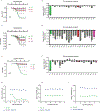Catalytic site mutations confer multiple states of G protein activation
- PMID: 36787384
- PMCID: PMC10021883
- DOI: 10.1126/scisignal.abq7842
Catalytic site mutations confer multiple states of G protein activation
Abstract
Heterotrimeric guanine nucleotide-binding proteins (G proteins) that function as molecular switches for cellular growth and metabolism are activated by GTP and inactivated by GTP hydrolysis. In uveal melanoma, a conserved glutamine residue critical for GTP hydrolysis in the G protein α subunit is often mutated in Gαq or Gα11 to either leucine or proline. In contrast, other glutamine mutations or mutations in other Gα subtypes are rare. To uncover the mechanism of the genetic selection and the functional role of this glutamine residue, we analyzed all possible substitutions of this residue in multiple Gα isoforms. Through cell-based measurements of activity, we showed that some mutants were further activated and inactivated by G protein-coupled receptors. Through biochemical, molecular dynamics, and nuclear magnetic resonance-based structural studies, we showed that the Gα mutants were functionally distinct and conformationally diverse, despite their shared inability to hydrolyze GTP. Thus, the catalytic glutamine residue contributes to functions beyond GTP hydrolysis, and these functions include subtype-specific, allosteric modulation of receptor-mediated subunit dissociation. We conclude that G proteins do not function as simple on-off switches. Rather, signaling emerges from an ensemble of active states, a subset of which are favored in disease and may be uniquely responsive to receptor-directed ligands.
Conflict of interest statement
Figures







Similar articles
-
Mechanism of the intrinsic arginine finger in heterotrimeric G proteins.Proc Natl Acad Sci U S A. 2016 Dec 13;113(50):E8041-E8050. doi: 10.1073/pnas.1612394113. Epub 2016 Nov 28. Proc Natl Acad Sci U S A. 2016. PMID: 27911799 Free PMC article.
-
New insights into the role of conserved, essential residues in the GTP binding/GTP hydrolytic cycle of large G proteins.J Biol Chem. 2006 Apr 7;281(14):9219-26. doi: 10.1074/jbc.M513837200. Epub 2006 Feb 9. J Biol Chem. 2006. PMID: 16469737
-
Distinct roles for two Galpha-Gbeta interfaces in cell polarity control by a yeast heterotrimeric G protein.Mol Biol Cell. 2008 Jan;19(1):181-97. doi: 10.1091/mbc.e07-04-0385. Epub 2007 Oct 31. Mol Biol Cell. 2008. PMID: 17978098 Free PMC article.
-
The GAPs, GEFs, and GDIs of heterotrimeric G-protein alpha subunits.Int J Biol Sci. 2005;1(2):51-66. doi: 10.7150/ijbs.1.51. Epub 2005 Apr 1. Int J Biol Sci. 2005. PMID: 15951850 Free PMC article. Review.
-
Invited review: Activation of G proteins by GTP and the mechanism of Gα-catalyzed GTP hydrolysis.Biopolymers. 2016 Aug;105(8):449-62. doi: 10.1002/bip.22836. Biopolymers. 2016. PMID: 26996924 Free PMC article. Review.
Cited by
-
Allosteric communication mechanism in the glucagon receptor.J Biol Chem. 2025 Jun;301(6):108530. doi: 10.1016/j.jbc.2025.108530. Epub 2025 Apr 23. J Biol Chem. 2025. PMID: 40280422 Free PMC article.
-
A molten globule ensemble primes Arf1-GDP for the nucleotide switch.Proc Natl Acad Sci U S A. 2024 Sep 24;121(39):e2413100121. doi: 10.1073/pnas.2413100121. Epub 2024 Sep 18. Proc Natl Acad Sci U S A. 2024. PMID: 39292747 Free PMC article.
-
Molecular annotation of G protein variants in a neurological disorder.Cell Rep. 2023 Dec 26;42(12):113462. doi: 10.1016/j.celrep.2023.113462. Epub 2023 Nov 18. Cell Rep. 2023. PMID: 37980565 Free PMC article.
-
A neurodevelopmental disorder mutation locks G proteins in the transitory pre-activated state.Nat Commun. 2024 Aug 5;15(1):6643. doi: 10.1038/s41467-024-50964-z. Nat Commun. 2024. PMID: 39103320 Free PMC article.
-
Molecular and Functional Profiling of Gαi as an Intracellular pH Sensor.Res Sq [Preprint]. 2024 Apr 30:rs.3.rs-4203924. doi: 10.21203/rs.3.rs-4203924/v1. Res Sq. 2024. Update in: Nat Commun. 2025 Apr 11;16(1):3468. doi: 10.1038/s41467-025-58323-2. PMID: 38746411 Free PMC article. Updated. Preprint.
References
-
- Buck LB, The Molecular Architecture of Odor and Pheromone Sensing in Mammals. Cell. 100, 611–618 (2000). - PubMed
-
- Margolskee RF, Molecular Mechanisms of Bitter and Sweet Taste Transduction. Journal of Biological Chemistry. 277, 1–4 (2002). - PubMed
-
- Arshavsky VY, Lamb TD, Pugh EN, G Proteins and Phototransduction. Annurev.physiol 64, 153–187 (2003). - PubMed

